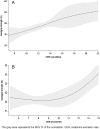Muscle mass determined from urinary creatinine excretion rate, and muscle performance in renal transplant recipients
- PMID: 30907512
- PMCID: PMC6596455
- DOI: 10.1002/jcsm.12399
Muscle mass determined from urinary creatinine excretion rate, and muscle performance in renal transplant recipients
Abstract
Background: Muscle mass, as determined from 24-h urinary creatinine excretion rate (CER), is an independent predictor for mortality and graft failure in renal transplant recipients (RTR). It is currently unknown whether CER is comparable with healthy controls after transplantation and whether it reflects muscle performance besides muscle mass. We aimed to compare urinary CER and muscle performance between RTR and healthy controls and to investigate whether urinary CER is associated with muscle performance in RTR.
Methods: We included RTR, transplanted between 1975 and 2016 in the University Medical Center Groningen. Healthy controls were subjects screened for kidney donation. CER was calculated from a 24-h urine collection. Muscle performance was assessed by handgrip strength, sit-to-stand test, and 2-min walk test. Statistical analyses were performed using linear regression analyses.
Results: We included 184 RTR (mean age 56.9 ± 11.9 years, 54% male recipient) and 78 healthy controls (age 57.9 ± 9.9, 47% male recipient). RTR were at a median time of 4.0 (1.1-8.8) years after transplantation. Mean CER was lower in RTR compared to healthy controls (11.7 ± 4.0 vs. 13.1 ± 5.2 mmol/24 h; P = 0.04). Significantly poorer results in muscle performance were found in RTR compared to controls for the handgrip strength (30.5 [23.7-41.1] N vs. 38.3 [29.3-46.0] N, P < 0.001) and the 2-min walk test (151.5 ± 49.2 m vs. 172.3 ± 12.2 m, P < 0.001) but not for the sit-to-stand (12.2 ± 3.3 m vs. 11.9 ± 2.8 m, P = 0.46). In RTR, CER was significantly associated with handgrip strength (std. β 0.33; P < 0.001), independent of adjustment for potential confounders. In RTR, CER was neither associated with the time used for the sit-to-stand test (std. β -0.09; P = 0.27) nor with the distance covered during the 2-min walk test (std. β 0.07; P = 0.40).
Conclusions: Muscle mass as measured by CER in RTR is lower compared to controls. CER is positively associated with muscle performance in RTR. The results demonstrate that CER does not only reflect muscle mass but also muscle performance in this patient setting. Determination of CER could be an interesting addition to the imaging technique armamentarium available and applied for evaluation of muscle mass in clinical intervention studies and observational studies.
Keywords: Creatinine excretion rate; Muscle mass; Muscle performance; Renal transplant recipients.
© 2019 The Authors. Journal of Cachexia, Sarcopenia and Muscle published by John Wiley & Sons Ltd on behalf of the Society on Sarcopenia, Cachexia and Wasting Disorders.
Conflict of interest statement
R.T.G. received consultancy fees and research funding from Otsuka, Ipsen, Sanofi‐Genzyme for polycystic kidney disease research. All money was paid to his institution. The other authors have no conflicts of interest to disclose.
Figures
References
-
- Wolfe R, Ashby V. Comparison of mortality in all patients on dialysis, patients on dialysis awaiting transplantation, and recipients of a first cadaveric transplant. NEJM 1999;341:1725–1730. - PubMed
-
- Merville P. Combating chronic renal allograft dysfunction: optimal immunosuppressive regimens. Drugs 2005;65:615–631. - PubMed
-
- Wolfe RR. The underappreciated role of muscle in health and disease. Am J Clin Nutr 2006;84:475–482. - PubMed
-
- Fried LF, Boudreau R, Lee JS, Chertow G, Kurella‐Tamura M, Shlipak MG, et al. Kidney function as a predictor of loss of lean mass in older adults: health, aging and body composition study. J Am Geriatr Soc 2007;55:1578–1584. - PubMed
Publication types
MeSH terms
Substances
LinkOut - more resources
Full Text Sources
Medical
Research Materials


